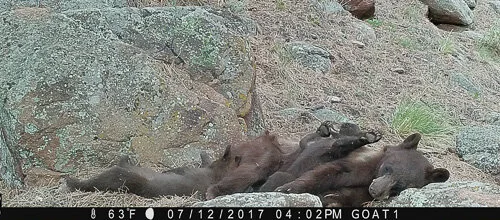The wonders of Black Bear biology
Black bear in summer
Photos and text by Rachel Ames, Estes Valley Watershed Coalition board member
Springtime is chaotic in the Estes Valley. While the sun shines brighter with each passing day, snowstorms come and go at random. The ungulates (deer, elk and moose) can’t figure out which fur coat to wear and are counting the days for the shrubs and grasses to green up so that they can finally eat something nutritious. Bluebirds are the season’s first arrivals and it never ceases to amaze me that they can find anything to eat! After 4-6 months of waiting out winter, black bears emerge from their dens to find a sometimes bleak or snow-covered landscape. We all know that black bears eat a lot in the fall, but what do they do during the rest of the year? In this article, I’ll discuss some of the more fascinating aspects of black bear biology and how bears make the most of each season.
Black bears are best known for their ability to eat and drink excessively in the late summer and fall as they fatten up for hibernation (the bulking-up phase is called hyperphagia). Those calories are crucial for their survival during their winter hibernation. While bears aren’t considered “true hibernators,” they do reduce their metabolic requirements and lower their body temperature. Bears sleep, or are in a state of torpor, for most of the winter, but they do wake up occasionally to groom themselves, change positions or even give birth. Around here, bears hibernate when the food supply becomes scarce. If it takes too much energy to find calories, then it makes sense to quit looking and conserve the calories they already have. Last fall was dry and there was less food available so the black bears tucked into their dens early. Around the Estes valley, a black bear den can be in a rock shelter or excavation under shrubs or trees. Bears prefer steep, north-facing slopes with good snow cover so that the temperature stays constant and the snow keeps them insulated.
What did they do all winter? Males, called boars, have had a relatively quiet nap, although they have lost about 20-27% of their body weight by the time spring comes around. On the other hand, females, called sows, have been busy if they gave birth during their hibernation. Pregnant females who gained enough weight during the fall’s hyperphagia will typically give birth in late January. Their newborn cubs weigh only ½ a pound and are blind and naked at birth. A sow will nurse and warm her cubs even though she has gone months without eating or drinking herself. By early March, her cubs weigh about 3 pounds and by month’s end they are about 6 pounds. Once the weather warms up, both males and females emerge from their dens. Males generally venture out sooner than females so the first bears we see in spring are typically males. While bears are hungry, they don’t just wake up and start eating right away, though. Months of starvation has left them a little constipated. Bears develop what is known as a “fecal plug.” This fecal plug is a hard, dried feces still in their colon which contains a bit of the fall’s undigested food, sloughed-off intestinal lining, hair, grass, and even some dried, callused skin from their foot pads. Since a bear periodically stirs during hibernation (and they often groom themselves or tidy up their den), anything ingested during this time sits in their digestive tract until spring. Thus, a bear’s digestive system starts up slowly. Ever feel like you’re sleep walking when you wake up after a long night? For bears this period is called “walking hibernation.” They typically don’t eat or drink much during this time, but their strong sense of smell helps them to check out food sources for future feasts. So now is definitely the time to secure your trash and bring in your attractants like bird seed and feeders.
Black bear with cubs
Once eating again, bears begin the process of gaining back their lost weight. Their favorite first course is grass. Green grass helps move their digestion along so that they can digest more substantial foods. While they like to eat “social insects” such as ants and insect larvae, they will gladly eat carrion and even kill small mammals such as squirrels and chipmunks. Their best sources of nutrition at this time are baby ungulates like deer fawns and elk calves! Bears spend lots of time crisscrossing their territory in search of newborn calves and fawns. Unfortunately, if a bear has learned that houses or cars contain food, then it will spend a lot of time investigating every car and quiet home in search of an easy meal.
Between early June and late August, things are relatively quiet for bears. There is plenty of food, but they don’t yet have access to the high calorie foods to “bulk up” for winter. What is a bear to do? Well, it turns out that early summer is a great time to find a mate! While a sow with cubs might not be interested, sows whose cubs are a year and a half, or cub-less females 5-years or older, are often eager to find a mate. Finding an interested partner is a time-consuming task. Both males and females leave scent marks on trees but finding each other can take time. A male also has to defend his territory and might end up losing another 20% of his body weight during the mating season. Once they find each other, bears mate often, but the female does not become pregnant right away – too risky. What happens if the fall harvest isn’t plentiful enough for cubs? Bear biology delays implantation. This means that a sow will carry an un-implanted fertilized egg (called blastocyst) with her until her body recognizes that she has the resources needed to care for her young. This might happen in November or December when she’s had time to fatten up. If it was a good year, she might have 3 cubs, but if it was a tough year, she may only have one, or none at all. In this way, black bears are well positioned to take advantage of the good years and survive through the tough ones. Their low birth rate also means that bears cannot recover very easily from drops in their populations. A young cub’s 6-month survival is directly linked to how much it interacts with humans. Young bear cubs who learn to scavenge human food rarely survive in the wild. For the cubs that can stay away from human food sources, there is much to learn about finding food, fattening up, picking a good hibernation den and finding a mate. A sow can spend a good year and a half teaching her cubs about their environment.
So, while spring is a tough time of year for ungulates, it is an exciting time of year for bears as they emerge from hibernation. We can help them safely transition into the season by remembering to always lock the doors and windows of our cars and homes, bringing in our bird feeders and attractants, and securing our trash. Not only will the black bears thank us, but we’ll be better protected against an onslaught of mice, too!
Black bear naps with cubs
More information about bears can be found at:
Estes Park Living with Wildlife: https://estespark.colorado.gov/wildlife
North American Bear Center: https://bear.org
Rocky Mountain National Park 2007 Bear Study: http://baldwin.ucdavis.edu/files/9613/8921/9124/Bear_Final_Report_2007_with_lit_review.pdf



